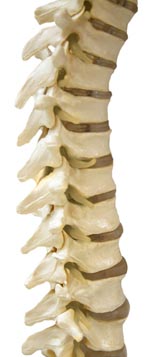First Aid for Spinal Injuries

Spinal injuries can be devastating in their long-term effect upon an individual.
What Is the Spine?
The spine is a column of bones stacked on each other with a central canal running from top to bottom. Through this canal, the spinal cord runs. The spinal cord is an extension of the brain and contains nerve fibres. Throughout the length or the spine, nerves branch off and provide sensation and stimulus to move different parts of the body. The closer the spine is to the brain, the more abundant the nerves. The spinal cord needs a constant supply of oxygen, which is provided by a network of blood vessels. The space through which the spinal cord moves is very restricted and leaves no room for swelling.
The Injured Spine
The body's normal response to injury is swelling. Unfortunately, with the spine there simply isn't enough space through the vertebrae to allow for this without causing other problems. When swelling occurs, the blood flow, and therefore the oxygen supply, to the spine become reduced. This in turn causes further swelling and thus more problems. As a first-aider your priorities are as follows:
- Ensure an open airway.
- Ensure optimum blood flow to the spinal cord.
- Prevent any movement.
Recognising a Spinal Injury
Always consider the possibility of a spinal injury following an accident.
The following accidents should always alert the first-aider to the possibility of a spinal injury:
- A fall from a height.
- A dive into shallow water.
- The casualty was thrown from a horse, motorbike or bicycle.
- Any traffic accident that causes rapid or sudden deceleration.
- Pedestrians hit by a vehicle.
- A heavy object fell on or across the casualty's back.
- Head or chest injuries.
You may notice:
- Complaint of neck or back pain.
- An abnormal shape to the spine.
- Tenderness over the affected part of the spine.
- Abnormal sensation of heaviness, stiffness, tingling and weakness.
- No sensation.
- Reduced, or loss of, control in limbs.
- Difficult or abnormal breathing.
- Incontinence.
Treatment:
- Check the casualty's mouth for any loose objects (like teeth) and remove. Check for breathing and a carotid pulse. Act accordingly.
- If resuscitation is necessary, move the head and neck very gently and with GREAT care.
- Never move the casualty as this could damage the spinal cord even further.
- Never tug or pull at the casualty's head.
- Do not lift the casualty's head.
- Do not support the neck with anything.
- Do not place your hand in the nape of the casualty's head.
- Tell the casualty (if he is conscious) not to move.
- Dial emergency services.
Head Injuries
A casualty suffering a head injury needs to be seen by a doctor. A casualty that was or is unconscious will be admitted to hospital for observation.
Scalp wounds bleed profusely and may indicate underlying injuries. The most useful indicator that a casualty suffered a head injury is an altered state of consciousness. There are four levels of consciousness; use the AVPU method to determine the casualty's level of consciousness.
| A Alert: | Normal level of consciousness. |
| V Voice: | The patient responds to your voice, but may be drowsy, keeps his eyes closed and may not speak coherently. |
| P Pain: | The patient is not alert and does not respond to your voice, but a painful stimulus, e.g. shaking the shoulders or possibly pinching an ear lobe, elicits a response. |
| U Unresponsive | Unconscious. |
If the casualty is unconscious, ensure that the casualty's airway is open, that the casualty is breathing and that the casualty has a carotid pulse. Act appropriately.
Compression
This occurs when pressure is exerted on the brain. The brain is contained within the skull and because of this, any bleeding or swelling will cause a pressure build-up around the brain. This is a potentially fatal condition and can become apparent immediately following the injury, or it can be delayed for quite some time. Medical attention is vital to recovery.
You will notice:
- A deterioration in consciousness.
- A history of a recent head injury.
- It is possible that initially it may look as if the casualty has made a full recovery.
You may notice:
- Disorientation and confusion.
- An intense headache.
- Unequal or unresponsive pupils.
- Breathing becomes slow and possibly noisy.
- Pulse becomes slow, but is strong and full.
Treatment:
- Stop any visible bleeding, but do not apply direct pressure if there is a suspected skull fracture.
- If the casualty is fully or semi-conscious, provide support by placing the casualty in a semi-sitting position.
- Dial emergency services.
- Continuously check the level of consciousness; if the casualty becomes unconscious, do emergency resuscitation if necessary.
- Always suspect a spinal injury.
Skull Fractures
The presence of skull fractures is always indicative of a head injury.
You may notice:
- Swelling.
- A soft area or dent on the head.
- A change in the shape of the head.
- A scalp wound.
- Blood in the white of the eyes.
- Straw coloured or bloodstained fluid seeping from the nose or ears.
Treatment:
- If the casualty is unconscious, ensure that the airway is open, that the casualty is breathing and that a carotid pulse is present. Act accordingly.
- If the casualty is conscious or semi-conscious, make him comfortable.
- If there is a discharge from the ear, apply light padding and position the casualty so that the ear is able to drain.
- Dial emergency services.
- Assess the casualty's level of consciousness regularly.
|